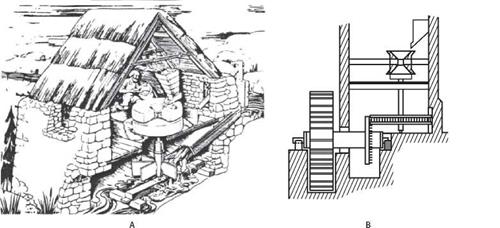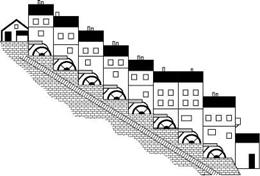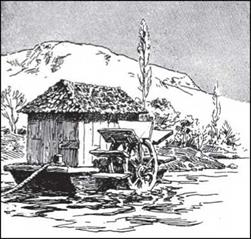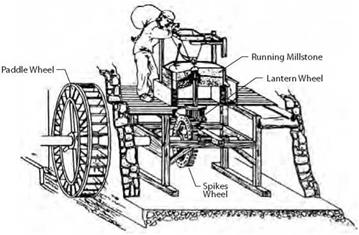GRINDING GRAINS INTO FLOUR
For thousands of years, grinding grains to make flour was the primary application of grinding technology. Beginning in about 100 bc, the development of mills driven by water and wind revolutionized the practice of agriculture. Although the importance of bread is underrated today, it is still the main food in many countries (Table 4.1).
WATERPOWER FOR GRINDING
The Water Wheel
The water wheel was one of the great engineering inventions, using energy from renewable natural resources for the first time. Harnessing waterpower caused a peaceful revolution that changed society irreversibly.
Water wheels were first used to drive rotary querns. Legend has it that this occurred in the eastern Mediterranean about 100 bc, a story that may have its roots in an epigram written by Antipater of Thessalonika around 85 bc, which recorded the significance of the miracle of waterpower. Antipater’s ode to the water wheel and the grinding mill (Bennett and Elton 1898-1904) is all the more pleasing because engineering achievements are rarely recognized in poetry:
Ye maids who toiled so faithful at the mill,
Now cease your work and from those toils be still:
Sleep now till dawn, and let the birds with glee Sing to the muddy morn on bush and tree:
For what your hands performed so long and true,
Ceres has charged the water-nymphs to do.
Pompeii’s soldiers found water wheels in the palace of King Mithridates VI after they conquered Pontus in 63 bc. It is not surprising that they were used there, because the kingdom was in a mountainous area on the southern coast of the Black Sea where many fast-flowing streams made it a suitable place for water wheels. But the Romans did not use waterpower widely until the shortage of slaves made it essential about 400 ad, and more than 1,000 years were to elapse before it became a general source of industrial energy.
TABLE 4.1 Consumption of bread in various countries in 1988 Consumption Range,
kg/head/yr Countries
150-200 Libya, Bulgaria, Egypt, Algeria, Morocco, Roman Empire (200 BC-400 AD)
100-150 Soviet Union, Greece, Hungary, Poland, Czechoslovakia
70-100 East Germany, Portugal, Belgium, Italy, Spain, West Germany
50-70 Ireland, France, Netherlands, New Zealand, Austria
20-50 Great Britain, Australia, United States, Sweden, Switzerland, Denmark
Source: Modified from Orth and Shellenberger 1988.
Water wheels can be operated with the wheel rotating in a horizontal plane driving a vertical shaft or in a vertical plane driving a horizontal shaft (Figure 4.1). The water wheel Antipater saw probably had a vertical shaft, because gears would not have been available and the shaft could be attached directly to the rotating stone. This type of mill was called a Greek water mill, no doubt because it was invented in a province of Greece. Mills driven by vertical wheels were called Roman water mills, probably because of their use by Roman engineers. Vertical wheels were more efficient than horizontal wheels because they could be built larger, and larger mills draw more power and grind more materials. In addition, the gearing allowed mill speeds to be changed. Vertical water wheels became the leading source of industrial power, dominating for about 1,500 years until the rise of steam power. Eventually, waterpower allowed inventors to design machines that greatly increased the volumes of metals, food, and fabrics produced. With water as the power source, engineers could undertake tasks that had previously been impossible, such as the large-scale production of iron and the dewatering of deep mines.
If there was a single key element distinguishing Western European technology from the technologies of Islam, Byzantium, India, or even China after about 1200, it was the West’s extensive commitment to and use of waterpower. For centuries the vertical water wheel was of critical importance, not only to western technology and the level of western industrial output, but also to the way western society evolved (Reynolds 1983).
Today, water wheels are little used as direct sources of power, although water is extensively used to drive hydraulic turbines (which are essentially large water wheels) for generating electrical power. But water mills with either horizontal or vertical wheels are still used for grinding grains in many countries.
Horizontal Water Wheels The most important requirement for a Greek mill was a fast-flowing stream of water. There were many suitable streams in the mountainous regions of Greece and Turkey, and in Asia as far afield as India and China. So it is not surprising that mills similar to the ancient Greek mills have been found far and wide, but we do not know whether they came from one source or emerged independently in different locations. A technique commonly used to drive water mills, which are querns driven by water wheels, is shown in Figure 4.1. Water is delivered through a pipe to the blades of a horizontal water wheel, and the wheel rotates a vertical shaft that drives the rotating stone of a quern.
Greek water mills are still the cheapest method of grinding grains in many villages. A mill driven by a horizontal water wheel near Corum in central Turkey has grinding stones that are 1.12 m in diameter and 0.26-m thick with a 0.22-m hole in the center. The stones are 20 years old and are used 12 hours per day for 5 months a year. The owner expects the stones to last for another 20 years. The mill produces either animal feed at 170 kg/hr or flour for human consumption at 100 kg/hr, and the owner is paid one-eighth of the value of the product.
The Greek water mill, like the mortar and pestle, is one of the few devices in use today that would be recognized instantly by those who operated them more than 1,500 years ago.
Vertical Water Wheels Vertical water wheels could take three forms (shown in Figure 4.2):
■ The undershot wheel, in which the water struck the paddles on the wheel at its base and moved them at the same velocity as the water
■ The overshot wheel, in which water filled the buckets on the wheel at the top and moved them by the velocity of the water and the potential energy of the filled buckets
■ The breastshot wheel, in which water filled the buckets about halfway up the wheel and moved them by the potential energy of the filled buckets
|
FIGURE 4.1 (a) Horizontal (Greek) and (b) vertical (Roman) water mills ([a] Reynolds 1983; reprinted by permission from University Minnesota Press [b] Reynolds 1983; reprinted by permission from Miriam Usher Chrisman) |
|
FIGURE 4.2 (a) Undershot or Roman vertical water wheel (b) the breastshot water wheel and (c) the overshot water wheel (O’Brien 1965) |
The undershot vertical water wheel described by the Roman engineer Marcus Vitruvius Pollio in 25 bc (Pollio 1931-1934) was probably invented about 50 years after the Greek mill.
The overshot wheel typically achieved efficiencies of 50% to 70%, much more than the undershot wheel at 15% to 30%, but it was more expensive because it required a dam, millrace, sluice gates, and a tailrace (Gille 1966). Despite their higher efficiency, water mills were not used much for grinding for a few hundred years after the vertical water wheel was developed—probably because slaves were cheap and plentiful, could operate querns efficiently by hand, and could fix problems that arose. But slavery slowly declined in the Roman Empire, and the Emperor Constantine, who ruled from 324 to 337, eventually issued an order that freed the slaves. This order was often evaded until an imperial edict was issued in 398 ad, which stringently enforced the protection of slaves, and then the need for another source of energy became urgent.
So it was that the Roman Empire gradually moved toward waterpower for grain grinding. Small water wheels were easy to build, but their capacity was limited. Large water wheels were expensive, but they could generate considerable power and drive high-capacity grain mills. Consequently, by the 4th century, Roman engineers were
|
|
building large water mills. One grain mill in Arles, France, had eight pairs of overshot water wheels (2 m in diameter) that operated in series, generating about 3 kW per wheel and producing flour for 80,000 people (Reynolds 1983; see Figure 4.3). The fall of water was 19 m, and each of the 16 wheels ground 2.5-3.0 tons in 10 hours. The mill at Arles did the work of about 1,500 slaves (Gimpel 1976).
Water mills were used extensively in the Roman Empire by the 4th century and were still being used in the 19th century (see Figure 4.4).
The mills in Rome were located in Janiculum, which is a hilly region on the western side of the Tiber River. An aqueduct brought water to the crest of the hill, and, as it flowed down the incline, gained sufficient velocity to drive the mills. During their siege of the city in 537, the Goths cut the water supply to starve the defenders, but the Byzantine general Belisarius built a floating undershot water wheel on the Tiber River to drive a flour mill that was placed on a boat. The invaders were repelled, at least for the time being (Reynolds 1983).
The vertical water wheel had two important effects on engineering: It increased the capacity of processes because it made more power available, and it demonstrated the importance of gears in drive mechanisms. It is not known when the gear that transmitted power from the vertical water wheel to the millstone was invented, but its use with querns was a significant engineering advance in its own right. The vertical wheel and the gear set the scene for the invention, 1,500 years later, of the water-powered stamp mill, which was extensively used for 400 years and was one of the longest-lasting size-reduction machines ever invented. After the collapse of the western Roman Empire in the 5th century, during the 500-year period known as the Dark Ages, waterpower spread throughout Europe; the type of flour mill used in medieval times is shown in Figure 4.5.
Little progress was made in the arts and sciences during the Dark Ages because the people who controlled the remnants of the Roman Empire had other interests. But grain mills were important, because there was no alternative to flour for bread making. We can surmise that grain milling improved during this 600-1,100-year period although few records exist about its progress. Water wheels did continue to proliferate as indicated in the records of the Domesday survey (The Domesday Book Online 1999-2004), which shows that, by 1086 in England, 5,624 water mills existed in 3,000 locations. Most were used to grind grain for about 1.4 million people (Gimpel 1976).
Because building a flour mill was quite expensive, a landlord, the church, or royalty usually owned the mills. Each farmer who brought grain to the mill paid a fee
|
|
|
FIGURE 4.4 Floating mill in Armenia in the 19th century with the undershot water wheel (Bennett and Elton 1898-1904)
|
FIGURE 4.5 Illustration of a flour mill used in medieval times (Godn and Wilm 1994)
or toll. In Europe, many of the smaller querns were destroyed in an effort to force people to use the king’s or church’s official mill. This also forced families to buy flour rather than being able to produce a small quantity for their own use (Planet Wheat 2002a, 2002b).
Grain mills driven by vertical water wheels still operate commercially in many parts of the world, although they are principally rehabilitated mills. Their revenue comes from sales of stone-ground flour and from fees paid by tourists who enjoy visiting the mills and watching the ancient grinding process. The Josephine mill in Cape Town, South Africa, near the famed Newlands cricket and football grounds, is typical of mills of this type. It has a breastshot water wheel that is 7.9 m in diameter and 1.4 m wide, with 70 buckets. On start-up, the wheel takes 12 L for the first three buckets and then operates
 |
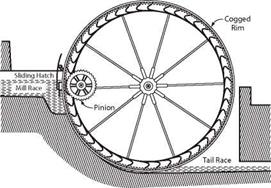 |
on 1 L per bucket. The grinding stones are 1.6 m in diameter. When the mill was in full operation, a pair of stones produced about 2 tons of flour in 24 hours (Figure 4.6; Walton 1978).

